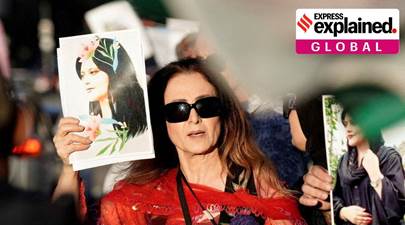Description

Copyright infringement not intended
Context: Nationwide protests over the death of a young Iranian Kurdish woman in the custody of Iran’s morality police have been at their most intense in the northwestern areas where the majority of the country’s 10 million Kurds live.
Details:
- The protests, now in their fourth week as demonstrators defy a crackdown by security forces, pose the biggest challenge to Iran’s clerical rulers in years.
- The demonstrations began in reaction to the death of 22-year-old Mahsa Amini and then spread to every one of Iran’s 31 provinces.
- The death of the ethnic Kurd raised tensions between the establishment and Iran’s Kurdish minority, which human rights groups say have been long oppressed by Iran’s leadership.

Who are Kurds?
- At an estimated 25 million to 35 million population, they are the world’s largest stateless ethnic group.
- The majority among the Kurdish people today are Sunni Muslim,but there are adherents of other faiths too, including Sufism and other mystical practices.
- They live in the highlands of southern and eastern Turkey, northern Iraq, the northeastern Syria, northwestern Iran, and parts of south Armenia, and are a minority in each of these countries. Small communities live in Georgia, Kazakhstan, Lebanon, and eastern Iran as well.
- Kurds have long had a reputation for being fearless fighters, and they have served as mercenaries in many armies over the centuries.

Copyright infringement not intended
Iranian kurds:
- The Kurds have never achieved nation-state status, except in Iraq, where they have a regional government called Iraqi Kurdistan.
- Kurdistan is made up of five different regions:southeastern Turkey, northeastern Syria, northern Iraq, northwestern Iran and southwestern Armenia.
- Minority Kurds, mainly Sunni Muslims in Shi’ite-dominated Iran, speak a language related to Farsi and live mostly in a mountainous region straddling the borders of Armenia, Iraq, Iran, Syria and Turkey.
Historical background:
- Kurdish nationalism stirred in the 1890s when the Ottoman Empire was on its last legs.
- The 1920 Treaty of Sevres promised Kurds independence. Three years later, Turkish leader Kemal Ataturk tore up that accord.
- The Treaty of Lausanne, ratified in 1924, divided the Kurds among the new nations of the Middle East.
- Kurdish separatism in Iran first bubbled to the surface with the 1946 Republic of Mahabad, a Soviet-backed state stretching over Iran’s border with Turkey and Iraq. It lasted one year before the central government wrested back control.
- Iran’s 1979 Islamic Revolution touched off bloodshed in its Kurdistan region with heavy clashes between the Shi’ite revolutionaries and the Kurdish Party of Iranian Kurdistan (KDPI) which fought for independence.
- After the 1980 eruption of the Iran-Iraq war, regular Iranian armed forces and Revolutionary Guards doubled down on their repression of Kurds so as to prevent them becoming a fifth column in Tehran’s fight against Saddam Hussein.
- New militant groups such as the Kurdistan Free Life Party (PJAK) have emerged over the past two decades and have occasionally clashed with security forces. Their leaders have often sought refuge in Iraqi Kurdistan and have been attacked by Iranian missiles.
- With eight million to 10 million Kurds living in Iran, Tehran fears pressure for secession will grow among a minority with a long history of struggle for its political rights.
- Rights groups say Kurds, who form about 10 percent of the population, along with other religious and ethnic minorities face discrimination under Iran’s Shi’ite clerical establishment.
https://indianexpress.com/article/explained/explained-global/who-are-iran-minority-kurds-mahsa-amini-death-in-custody-8201052/













